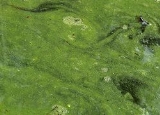
Cyanobacteria
Overview
Cyanobacteria is a phylum of bacteria
that obtain their energy through photosynthesis
. The name "cyanobacteria" comes from the color of the bacteria ( = blue).
The ability of cyanobacteria to perform oxygenic photosynthesis is thought to have converted the early reducing
atmosphere into an oxidizing one, which dramatically changed
the composition of life forms on Earth by stimulating biodiversity
and leading to the near-extinction of oxygen-intolerant organisms
.
Bacteria
Bacteria are a large domain of prokaryotic microorganisms. Typically a few micrometres in length, bacteria have a wide range of shapes, ranging from spheres to rods and spirals...
that obtain their energy through photosynthesis
Photosynthesis
Photosynthesis is a chemical process that converts carbon dioxide into organic compounds, especially sugars, using the energy from sunlight. Photosynthesis occurs in plants, algae, and many species of bacteria, but not in archaea. Photosynthetic organisms are called photoautotrophs, since they can...
. The name "cyanobacteria" comes from the color of the bacteria ( = blue).
The ability of cyanobacteria to perform oxygenic photosynthesis is thought to have converted the early reducing
Redox
Redox reactions describe all chemical reactions in which atoms have their oxidation state changed....
atmosphere into an oxidizing one, which dramatically changed
Great Oxygenation Event
The Great Oxygenation Event , also called the Oxygen Catastrophe or Oxygen Crisis or Great Oxidation, was the biologically induced appearance of free oxygen in Earth's atmosphere. This major environmental change happened around 2.4 billion years ago.Photosynthesis was producing oxygen both before...
the composition of life forms on Earth by stimulating biodiversity
Biodiversity
Biodiversity is the degree of variation of life forms within a given ecosystem, biome, or an entire planet. Biodiversity is a measure of the health of ecosystems. Biodiversity is in part a function of climate. In terrestrial habitats, tropical regions are typically rich whereas polar regions...
and leading to the near-extinction of oxygen-intolerant organisms
Anaerobic organism
An anaerobic organism or anaerobe is any organism that does not require oxygen for growth. It could possibly react negatively and may even die if oxygen is present...
.
Unanswered Questions
Discussions

